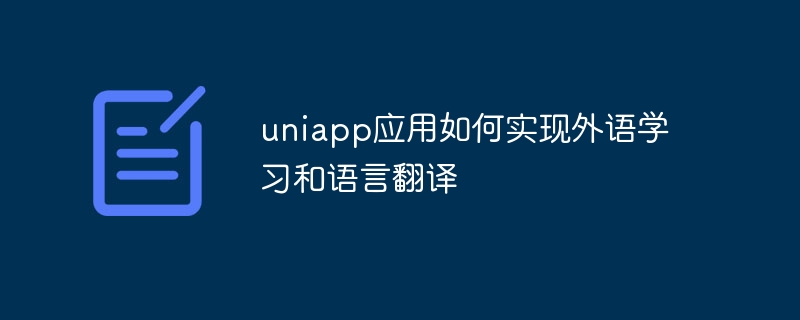Home >Web Front-end >uni-app >How uniapp application enables foreign language learning and language translation
How uniapp application enables foreign language learning and language translation
- WBOYWBOYWBOYWBOYWBOYWBOYWBOYWBOYWBOYWBOYWBOYWBOYWBOriginal
- 2023-10-25 12:00:431523browse

Uniapp is a cross-platform mobile application development framework developed based on Vue.js. It can develop iOS, Android and H5 applications at the same time, combining the experience of native applications and the development of web applications. efficiency. This article will introduce how to use Uniapp to implement foreign language learning and language translation functions, and provide some specific code examples.
1. Implementation of foreign language learning functions
The foreign language learning functions mainly include word learning, grammar learning, listening practice, etc. The following is a simple word study example:
-
Create a word study page named wordStudy.vue.
<template> <view> <text>{{ currentWord }}</text> <button @click="nextWord">下一个</button> </view> </template> <script> export default { data() { return { words: ["apple", "banana", "cat"], currentIndex: 0, currentWord: "" } }, mounted() { this.currentWord = this.words[this.currentIndex]; }, methods: { nextWord() { if (this.currentIndex < this.words.length - 1) { this.currentIndex++; this.currentWord = this.words[this.currentIndex]; } } } } </script> -
Introduce the wordStudy.vue component into App.vue.
<template> <view> <word-study></word-study> </view> </template>
-
Configure routing so that the wordStudy page can be accessed through routing jumps.
export default new Router({ routes: [ { path: '/wordStudy', name: 'wordStudy', component: () => import('@/pages/wordStudy.vue') } ] })Through the above code, we can display a simple word learning page, and click the "Next" button to switch to the next word.
2. Language translation function implementation
The language translation function can use third-party translation APIs, such as Baidu Translation API. The following is an example of translation implemented using Baidu Translation API:
-
Introduce axios in main.js to send HTTP requests.
import axios from 'axios' Vue.prototype.$http = axios
-
Create a translation page named translation.vue.
<template> <view> <textarea v-model="inputText"></textarea> <button @click="translate">翻译</button> <text>{{ result }}</text> </view> </template> <script> export default { data() { return { inputText: "", result: "" } }, methods: { translate() { this.$http.get("https://fanyi-api.baidu.com/api/trans/vip/translate", { params: { q: this.inputText, from: "auto", to: "zh", appid: "yourAppId", salt: "randomSalt", sign: "sign" } }) .then(res => { this.result = res.data.trans_result[0].dst; }) .catch(err => { console.error(err); }); } } } </script> -
Introduce the translation.vue component into App.vue.
<template> <view> <translation></translation> </view> </template>
-
Configure routing so that the translation page can be accessed through routing jumps.
export default new Router({ routes: [ { path: '/translation', name: 'translation', component: () => import('@/pages/translation.vue') } ] })Through the above code, we can display a simple translation page. After entering the text, click the "Translate" button to translate the entered text into Chinese.
Summary
This article introduces how to use Uniapp to implement the functions of foreign language learning and language translation, and demonstrates the implementation process of word learning and language translation through sample code. In actual development, functions can be customized and expanded according to specific needs, and more learning and translation functions can be added. I hope this article can be helpful to Uniapp developers and foreign language learners.
The above is the detailed content of How uniapp application enables foreign language learning and language translation. For more information, please follow other related articles on the PHP Chinese website!

